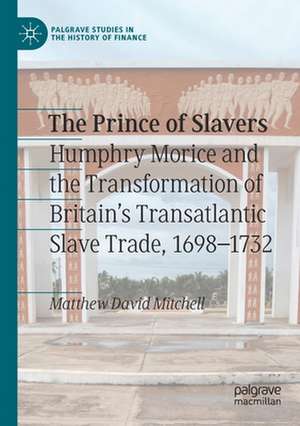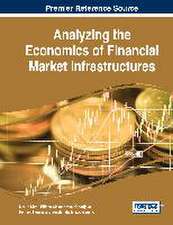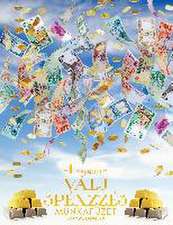The Prince of Slavers: Humphry Morice and the Transformation of Britain's Transatlantic Slave Trade, 1698–1732: Palgrave Studies in the History of Finance
Autor Matthew David Mitchellen Limba Engleză Paperback – 5 feb 2021
Morice’s strategy was well adapted for managing the special risks of the trade, and for duplicating, at lower cost, the RAC’s capabilities for gathering information on what African slave-sellers wanted in exchange. Still, Morice’s transatlantic operations were expensive enough to drive him to a series of increasingly dubious financial manoeuvres throughout the 1720s, and eventually to large-scale fraud in 1731 from the Bank of England, of which he was a longtime director. He died later that year, probably by suicide, and with his estate hopelessly indebted to the Bank, his family, and his ship captains. Nonetheless, his astonishing rise and fall marked a turning point in the development of the brutal transatlantic trade in enslaved Africans.
| Toate formatele și edițiile | Preț | Express |
|---|---|---|
| Paperback (1) | 726.06 lei 43-57 zile | |
| Springer International Publishing – 5 feb 2021 | 726.06 lei 43-57 zile | |
| Hardback (1) | 736.32 lei 43-57 zile | |
| Springer International Publishing – 5 feb 2020 | 736.32 lei 43-57 zile |
Din seria Palgrave Studies in the History of Finance
-
 Preț: 362.10 lei
Preț: 362.10 lei - 9%
 Preț: 764.93 lei
Preț: 764.93 lei - 9%
 Preț: 626.29 lei
Preț: 626.29 lei - 18%
 Preț: 737.26 lei
Preț: 737.26 lei - 15%
 Preț: 522.89 lei
Preț: 522.89 lei -
 Preț: 451.65 lei
Preț: 451.65 lei - 15%
 Preț: 701.06 lei
Preț: 701.06 lei - 18%
 Preț: 726.37 lei
Preț: 726.37 lei - 15%
 Preț: 712.22 lei
Preț: 712.22 lei - 15%
 Preț: 530.25 lei
Preț: 530.25 lei - 18%
 Preț: 1114.21 lei
Preț: 1114.21 lei - 18%
 Preț: 1006.55 lei
Preț: 1006.55 lei - 18%
 Preț: 786.84 lei
Preț: 786.84 lei - 18%
 Preț: 792.03 lei
Preț: 792.03 lei - 18%
 Preț: 724.94 lei
Preț: 724.94 lei - 15%
 Preț: 702.54 lei
Preț: 702.54 lei - 18%
 Preț: 723.69 lei
Preț: 723.69 lei -
 Preț: 388.72 lei
Preț: 388.72 lei - 15%
 Preț: 694.19 lei
Preț: 694.19 lei - 18%
 Preț: 782.72 lei
Preț: 782.72 lei - 15%
 Preț: 637.59 lei
Preț: 637.59 lei - 18%
 Preț: 1108.51 lei
Preț: 1108.51 lei - 9%
 Preț: 920.30 lei
Preț: 920.30 lei - 15%
 Preț: 711.89 lei
Preț: 711.89 lei -
 Preț: 383.12 lei
Preț: 383.12 lei - 18%
 Preț: 891.33 lei
Preț: 891.33 lei - 18%
 Preț: 958.25 lei
Preț: 958.25 lei - 18%
 Preț: 1008.28 lei
Preț: 1008.28 lei -
 Preț: 445.88 lei
Preț: 445.88 lei - 18%
 Preț: 1113.58 lei
Preț: 1113.58 lei - 15%
 Preț: 646.75 lei
Preț: 646.75 lei - 15%
 Preț: 702.05 lei
Preț: 702.05 lei -
 Preț: 450.11 lei
Preț: 450.11 lei - 18%
 Preț: 794.39 lei
Preț: 794.39 lei - 18%
 Preț: 948.29 lei
Preț: 948.29 lei - 15%
 Preț: 697.97 lei
Preț: 697.97 lei - 18%
 Preț: 728.74 lei
Preț: 728.74 lei
Preț: 726.06 lei
Preț vechi: 885.44 lei
-18% Nou
Puncte Express: 1089
Preț estimativ în valută:
138.93€ • 145.44$ • 114.96£
138.93€ • 145.44$ • 114.96£
Carte tipărită la comandă
Livrare economică 07-21 aprilie
Preluare comenzi: 021 569.72.76
Specificații
ISBN-13: 9783030338411
ISBN-10: 303033841X
Pagini: 317
Ilustrații: XVIII, 317 p. 2 illus. in color.
Dimensiuni: 148 x 210 mm
Greutate: 0.4 kg
Ediția:1st ed. 2020
Editura: Springer International Publishing
Colecția Palgrave Macmillan
Seria Palgrave Studies in the History of Finance
Locul publicării:Cham, Switzerland
ISBN-10: 303033841X
Pagini: 317
Ilustrații: XVIII, 317 p. 2 illus. in color.
Dimensiuni: 148 x 210 mm
Greutate: 0.4 kg
Ediția:1st ed. 2020
Editura: Springer International Publishing
Colecția Palgrave Macmillan
Seria Palgrave Studies in the History of Finance
Locul publicării:Cham, Switzerland
Cuprins
Chapter 1: Introduction.- Chapter 2: Prologue to Morice: Anglo-African Trade under the Royal African Company Monopoly.- Chapter 3: Morice’s Peers: The Early British Separate Traders.- Chapter 4: Morice’s Beginnings:1704-1719.- Chapter 5: Morice at the Peak, 1720-1727.- Chapter 6: Morice’s Catastrophe, 1728-1731 and Beyond.- Chapter 7. Conclusion.- Chapter 8. Morice's Africa Voyages: An Annotated List.
Recenzii
“Mitchell presents facts and conclusions … succeeds in making us think of questions for further research. I recommend this book to those who are interested in the transatlantic slave trade and in business history in general.” (Jose Rowell Corpuz, EH Net, eh.net, December, 2023)
Notă biografică
Matthew David Mitchell is Assistant Professor of British History at Sewanee: The University of the South, USA.
Textul de pe ultima copertă
“A wonderful achievement... smart, beautifully written, interesting, informative. Morice himself is an intriguing character... We have so few really rich studies of individual slave traders that this too is a major contribution.”
—Randy J. Sparks, Tulane University, USA
Much scholarship on the British transatlantic slave trade has focused on its peak period in the late eighteenth century and its abolition in the early nineteenth; or on the Royal African Company (RAC), which in 1698 lost the monopoly it had previously enjoyed over the trade. During the early eighteenth-century transition between these two better-studied periods, Humphry Morice was by far the most prolific of the British slave traders. He bears the guilt for trafficking over 25,000 enslaved Africans, and his voluminous surviving papers offer intriguing insights into how he did it.
Morice’s strategy was well adapted for managing the special risks of the trade, and for duplicating, at lower cost, the RAC’s capabilities for gathering information on what African slave-sellers wanted in exchange. Still, Morice’s transatlantic operations were expensive enough to drive him to a series of increasingly dubious financial manoeuvres throughout the 1720s, and eventually to large-scale fraud in 1731 from the Bank of England, of which he was a longtime director. He died later that year, probably by suicide, and with his estate hopelessly indebted to the Bank, his family, and his ship captains. Nonetheless, his astonishing rise and fall marked a turning point in the development of the brutal transatlantic trade in enslaved Africans. This book is an invaluable read for scholars of financial and commercial history.
—Randy J. Sparks, Tulane University, USA
Much scholarship on the British transatlantic slave trade has focused on its peak period in the late eighteenth century and its abolition in the early nineteenth; or on the Royal African Company (RAC), which in 1698 lost the monopoly it had previously enjoyed over the trade. During the early eighteenth-century transition between these two better-studied periods, Humphry Morice was by far the most prolific of the British slave traders. He bears the guilt for trafficking over 25,000 enslaved Africans, and his voluminous surviving papers offer intriguing insights into how he did it.
Morice’s strategy was well adapted for managing the special risks of the trade, and for duplicating, at lower cost, the RAC’s capabilities for gathering information on what African slave-sellers wanted in exchange. Still, Morice’s transatlantic operations were expensive enough to drive him to a series of increasingly dubious financial manoeuvres throughout the 1720s, and eventually to large-scale fraud in 1731 from the Bank of England, of which he was a longtime director. He died later that year, probably by suicide, and with his estate hopelessly indebted to the Bank, his family, and his ship captains. Nonetheless, his astonishing rise and fall marked a turning point in the development of the brutal transatlantic trade in enslaved Africans. This book is an invaluable read for scholars of financial and commercial history.
Caracteristici
Demonstrates why the vast majority of the early independent British slave traders lacked the capital, both financial and informational, to succeed in the slave trade Analyses Morice's voluminous surviving papers and offers intriguing insights into his strategy Connects Morice’s business practices with the “commodification” of enslaved human beings on the Middle Passage




















